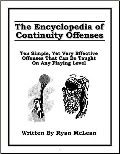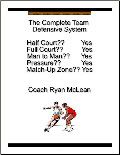Here's a little sample:
"Let's begin by parsing the appellation of this offense. Calling it the Princeton Offense is like calling Yankee Stadium "The House That DiMaggio Built." While Princeton made this offense popular, Pete Carril did not invent it. I cannot say just how far back it goes, but the Boston Celtics ran this type of offense as their high-percentage game as far back as the late 1950's when Coach Red Auerbach had sleight-of-hand wizards like Bob Cousy and Bill Sharman in his backcourt. The Celtics usually relied on this offense to get demoralizing crip shots once their vaunted fast break gave them a nice lead.
Initially Carril's Princeton teams played at a faster pace. They employed a pressure man-to-man defense and relied on the fast break. Players like Geoff Petrie, John Hummer, Armond Hill, Brian Taylor, and Ted Manakas could run with anybody. The faster-paced Tigers won the 1975 NIT when that championship meant you were one of the top 20 teams in the nation. The Tigers scored 80 or more points in three of the four NIT games.
As 1975-76 approached, Coach Carril was faced with a dilemma. Too much of his team's tactical speed had graduated. His roster wasn't proficient for playing pressure man defense. What he had was a group of intelligent team players who were fine shooters. So, Carril installed a match up zone defense and relied more and more on his backdoor offense and less and less on a transition game.
Princeton still continued to win, sharing Ivy League dominance with rival Penn for the next two decades. Player like Barnes Hauptfuhrer, Frank Sowinski, Billy Omeltchenko, and Bob Roma continued to bring Princeton all-Ivy accolades. Other Ivy stars followed in the ensuing years. Make no mistake about it; Princeton kept winning because Carril kept identifying top talent that could enroll at the excellent school.
That's enough about Princeton. Let's return to the Ivy League school of the Southeastern Conference.
Let's move forward to 2003. Vanderbilt had just completed their worst basketball season since football assistants were coaching the team. Included in the low-water mark was a 62-point blowout loss to Kentucky. The offense had difficulty just advancing the ball into the scoring zone. By the time the next season started, Vanderbilt was now running their version of the backdoor offense. With exceptional talent playing together as a team and with Matt Freije leading by example, Vandy began 2003-04 with 12 consecutive victories. The season culminated with a trip to the Sweet 16 and 23 wins.
The same offense has remained in place since then. How does it work? To start with, this is not a set pattern offense where each player has a specific duty to carry out (like a football play). Each player is presented with multiple options based on how he perceives the defense to be playing. Thus, each player must make split-second decisions while the game is progressing. A player might have four or five different options available to himself in just five seconds of action. When the offensive players recognize the defensive weaknesses on a possession and execute the philosophy correctly and on the same page, it usually results in an embarrassing defeat for the defense on that possession. If there are enough embarrassments, Vandy wins the game."
Here's the direct link for the rest of the article.





No comments:
Post a Comment